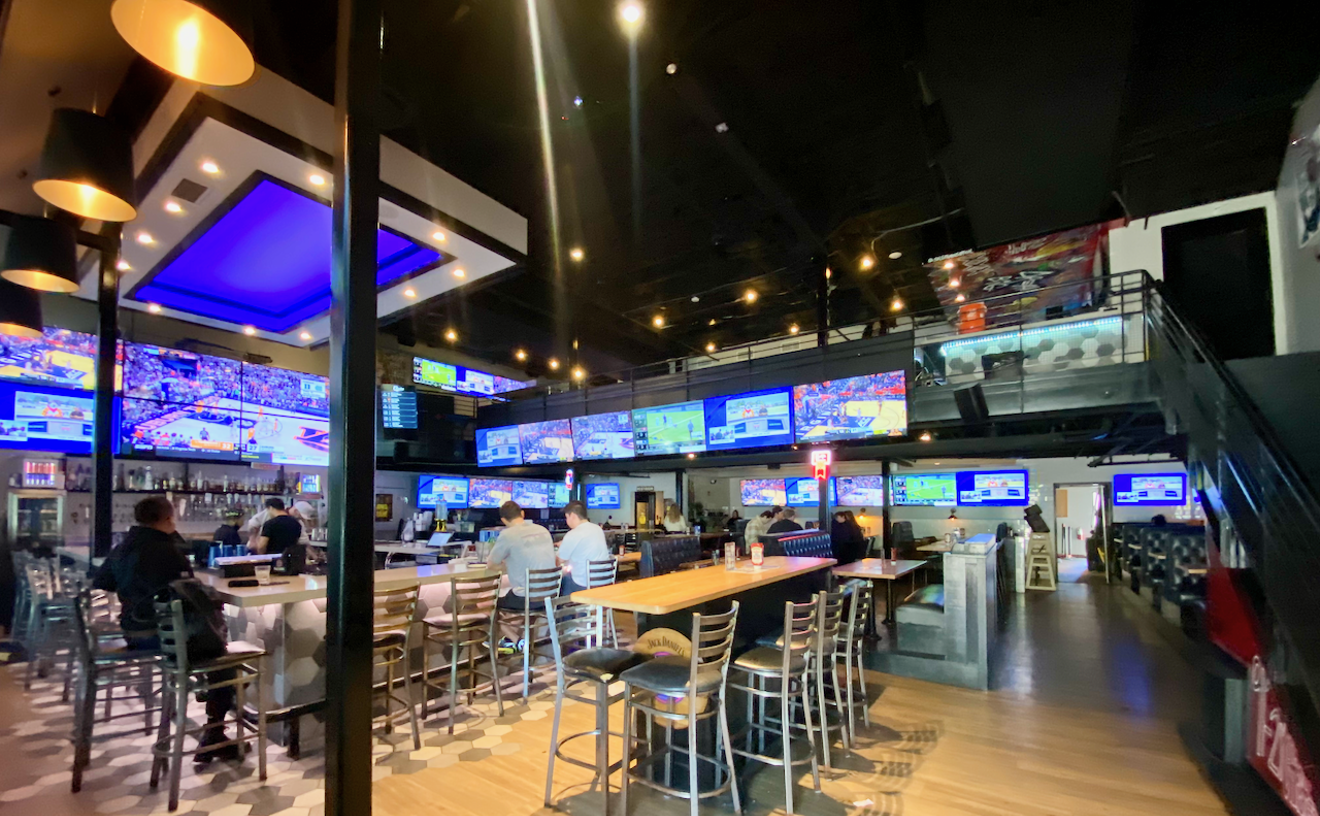Once upon a time, supper clubs ruled the American dining scene. These were fancy dress and cocktail destinations with cigarette girls roaming the aisles and big bands providing ambience.
Now and again, someone will catch an old black and white film and be captivated enough by the elegance of such settings to revive the tradition. Benny Goodman, Cary Grant, glittering gowns...who wouldn't want to exchange a few hours of their day-to-day lives for a little fantasy? Unfortunately, the country's interest in nostalgia comes in waves far too brief for any real success at this—unless the restaurant owner fesses up to reality and renders something entirely new, with one or two homages to the past.
Walk into Fedora and—after you almost trip over the long bench blocking the entry—a bit of that supper club feeling washes over you. There are the high-backed, clamshell booths, a svelte bar, classic dishes like osso bucco and a wall studded with two-tone photos. Even the flat screens mounted in this gallery are switched to good old-fashioned black and white.
But there's another, more troubling sensation: the "this can't last" aura that often surrounds Dallas theme restaurants, both trifling and ostentatious. Just glancing around, you can feel the place teetering along the concept's treacherous edge.
I say that because even the most well-designed concept—and this is a handsome room—puts extraordinary pressure on food service. The kitchen must live up to, even exceed, the kitsch and décor in order for the place to survive. Fedora, however, specializes in solid, often simple dishes. When they push the bounds of convention, even just a bit, it comes across as irrational, though not necessarily unpleasant. Something they call "lasagna-male" represents their stab at Italian-Mexican fusion, in the form of a tamale with polenta masa. It's not such a stretch: polenta and masa (and even grits) are based on ground corn, and there's little to distinguish between the two in this particular creation. But they pile it on thick. The meat is sparse, and the supporting cast far too demure, so it feels as if you're spooning mounds of dull corn porridge.
There's nothing to suggest lasagna, either—calling into question its fusion credentials.
On the other end of things, their classic osso bucco fixes tender cubes of meat against commonplace risotto, al dente grains but bound by a keen, glue-like mass. On the plus side, the meat bears musty, grassy and herbal flavors seeping through each bite—a bit less straightforward than the traditional Milanese version, it would seem, but hearty and pleasant because of it. And they provide you with more than enough to satisfy famished diners. The marrow's gooey texture, however, is hardly appetizing. It's difficult, as well, to justify the damn near $40 price tag.
The true art of preparing Italian cuisine in this country has always been in the pricing. Old country dishes tend to rely on simplicity and seasonal ingredients so bursting with fresh flavors it's nearly impossible not to enjoy the experience. Former working-class dishes, such as crudo—raw fish carved from the day's catch for the boat's crew—and carbonara, a filling laborer's favorite, end up on fancy menus. But the wisdom of spending good money on pasta has always been somewhat doubtful. The marginal difference between quality store-bought brands and the stuff served in many restaurants is much smaller than the price. Fedora's penne falls within al dente territory, and the sauce reverberates with the rustic, earthy taste of mushroom, approaching softly before more piercing, salty characters emerge.
It's warm, and you will finish the plate happily. But it's also common and easy to forget—not a fault, as such, but the nature of an easy pasta course dish.
So where is the restaurant's appeal? You have to forgive them for serving dull, though supposedly heirloom, tomatoes this time of year. The caprese must lean on mozzarella and the salad's accoutrements—in this case, bright, grassy olive oil and the spearmint bite of basil. The cheese weighs in with a gentle, milky essence—the very thing you expect from decent mozzarella. But it also reveals some gritty texture, the sign of an ill-spun or sagging batch. Not bad, but slightly disappointing, although it may be worth revisiting once fresh local tomatoes come available.
An antipasto platter of cured meats and cheeses seems rather effeminate compared with the hulking, hefty servings you find in many Italian restaurants, both here and abroad: meat sheered so finely it's possible to peer through each slice, sacrificing robust character in favor of fine, almost effete mouth feel. The cheeses tend toward pungent with an appropriate variation between soft and firm. Any real interest comes from a sweet and husky onion jam and a relatively spectacular tapenade. Fierce in nature, ripened by brine, the familiar taste of olive eventually caves in to an assertive (in the George Patton sense of the word) barrage of garlic. At first bite, the intense combination sends your taste buds scurrying for cover. But there's something compelling. You must have more and more—until you recognize a flaw management should have seen long ago: the tapenade needs a foil.
Simply put, it's a sauce without purpose. To spread it on cheese, well, that would be rather pointless. And to slather it on paper-thin veneers of cured meat...what's the point? The restaurant needs to provide crisp flatbread or spongy white slices to bring out the full beauty of this tapenade.
But they don't.
Oh, well—back to the question at hand. The ownership group includes a Campisi daughter, bringing (one assumes) decades of knowledge to the enterprise. They've put together a tremendous space—hip and comfortable at the same time, warmed by nostalgia but also as dark and mysterious as the hottest lounge. That "can't last" aura still hangs in the air, though.
Why? Well, I'm judging it as a restaurant and, right now, the food service concept falls short of the room itself. Nothing poorly presented, mind you, no huge flaws in technique. It's just too everyday and forgettable to be worthy of the destination tag.
Should you drive from the north to check out Fedora's menu? Nah, not really—unless you have to try the city's newbie restaurants at least once. The bar, however, is pretty damn cool.
There it is.
1722 Routh St. (One Arts Plaza), 214-999-0009. Open 11 a.m.-10 p.m. Monday-Thursday, 11 a.m.-midnight Friday, 5 p.m.-midnight Saturday (lunch service 11 a.m.-2:30 p.m.; bar menu starts at 2:30 p.m.; dinner begins at 5:30 p.m.). $$-$$$










